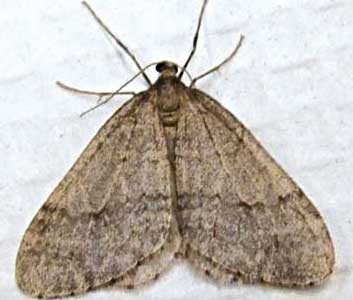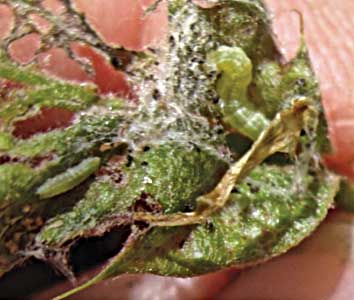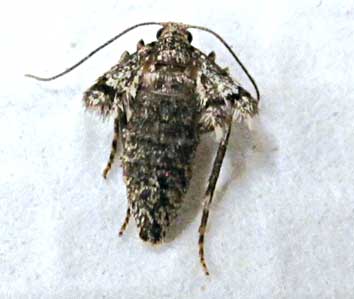 |
|
Winter moth adult, male. |
 |
|
Winter moth caterpillars. |
 |
|
Winter moth adult, female. |
By C.J. Walke
Winter is settling in, and our trees and gardens lay dormant – soon, we hope, to be under a blanket of snow for a little insulation for the soil and for a foot or 2 of higher reach for our pruning in a few more months. If the snow has not yet fallen, it is not too late to wrap vole guards on any forgotten tree trunks or spread wood chip mulch within drip lines. In some years I have push-mowed under trees in early December to grind up leaf debris and try to stay ahead of fungal pressure in early spring, but more on that later in the article.
Winter Moth
Winter moth (Operophtera brumata) is becoming a common pest along the coast of Maine and in southern Maine areas, according to comments I hear from growers, and it appears to be growing in importance for blueberry, apple and pear growers in southeastern New England according to reports from Cornell University and UMass. Damage occurs when larvae feed in early spring, so if you’ve noticed that new growth is already damaged when leaf buds or flower buds start to open, you most likely have winter moth. Other moths have similar habits, but not so severe.
Larvae hatch from eggs laid on the tree when apple buds are at green tip. They make their way into buds between the bud scales, typically without feeding. This is the main point I want to make, because in the past I have recommended a Bt spray (Dipel DF) at this point to kill these larvae as they enter buds. However, the larvae need to ingest Bt to be killed, and since they are not eating their way into buds, Bt will not be effective. A spinosad product such as Entrust for commercial growers or Monterey Garden Insect Spray for home gardeners will work on contact with the larvae and doesn’t require ingestion. Dormant oil sprays before egg hatch should smother eggs on the tree, if applied thoroughly.
Feeding occurs for about six weeks, and larvae may “balloon” from one tree to another on silken threads, which may occur after any spray treatments. Caterpillars are light green with a white stripe down the side of the body, and they are loopers, so they move in the “inchworm” style. By late May, the larvae will drop to the ground and pupate in the soil, emerging in November as adults to breed and lay eggs. Female moths are flightless and scurry up tree trunks to lay their eggs. This is where sticky tree bands can trap females or cause them to lay eggs on the lower part of the trunk if they do not try to cross the sticky barrier. You can make sticky barriers by wrapping duct tap, foam tape or plastic wrap (or a combination of these) around the trunk, then applying Tanglefoot to the wrap. The key is to get the wrap into bark crevices so that the moths cannot creep underneath, and not to get the Tanglefoot on the tree trunk. These wraps can be placed on the trunk 1 or 2 feet from the ground, then are easily cut off in January when moth emergence should be complete.
Fabraea Leaf Spot
I am also hearing more about Fabraea leaf spot, a fungal disease that affects pear and quince fruit and foliage, and that can defoliate trees and deform or destroy fruit when severe. In some areas of the country, Fabraea leaf spot is considered the second most important disease of pear orchards after fire blight. As a fungal disease, the infection occurs very similar to that of pear and apple scabs, with a primary stage in early spring and summer, and secondary infections occurring throughout the summer when conditions are right, especially in wet seasons.
Fabraea first appears as round, purplish spots on both sides of leaves and on fruit, which eventually grow to lesions one-eighth to one-quarter inch is size. I previously assumed these lesions were pear scab. Both diseases can occur on the same untreated trees, but Fabraea leaf spot tends to be smaller, flatter and grayer in appearance, where pear scab lesions are blacker, tend to be larger and will crack fruit when advanced. Bosc and Seckel tend to have higher susceptibility than other European varieties. In Southeastern states, the disease also infects shoots, causing purplish cankers, but in the Northeast infection seems to be mostly on leaves and fruit, although shoot infection is possible.
The fungus overwinters on infected leaves and fruit, similar to pear and apple scabs, so orchard sanitation is the best cultural approach to minimize Fabraea presence in the spring. Removing all fruit from the tree and mowing leaf litter in late fall, combined with applying a nitrogen source such as fish hydrolysate or spreading finished compost, will increase decomposition of infected leaf matter, reducing fungal pressures come spring. The same can be done in early spring, if winter came too quickly or if disease pressure was high the previous year and you want to be thorough.
C.J. Walke is MOFGA’s organic orchardist. You can contact him at [email protected].
